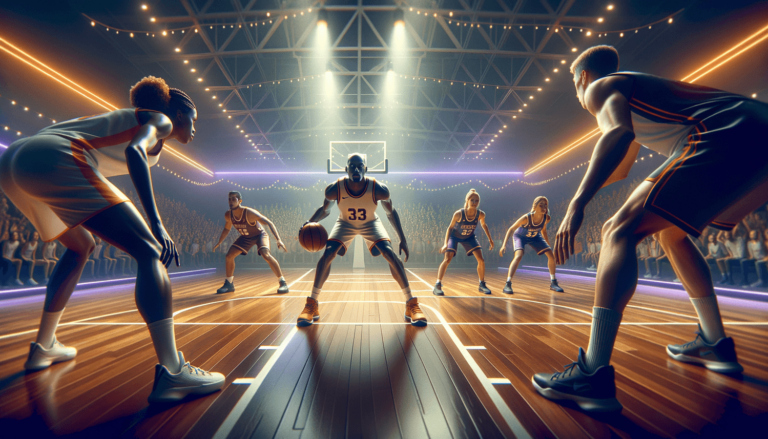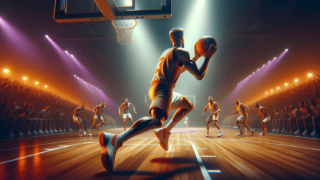
Get ready to lock in, because we’re about to take a deep dive into the fundamentals of defense in the world of basketball! Introducing the defensive stance, an essential aspect of the game that often flies under the radar, yet commands great respect from players and coaches alike. Effective defense can win games, and mastering the defensive stance is where it all begins. In this engaging and informative blog post, we’ll unravel everything there is to know about the art of the defensive stance. So, lace up those basketball shoes, adopt that low power posture, and let’s get started!
What’s a Defensive Stance in Basketball?
A defensive stance in basketball is a fundamental posture and footwork technique that allows players to effectively guard their opponents, react quickly, and maintain balance. It involves spreading the feet shoulder-width apart, bending the knees slightly, keeping the back straight, and positioning the arms actively to contest shots and passes. This stance helps defenders stay agile, prepared, and ready to adjust their position or jump to block a shot efficiently.
The Importance of a Defensive Stance
When it comes to the game of basketball, offense might steal the spotlight, but it’s the foundation of a strong defense that often determines which team comes out on top. In any basketball game, mastering the defensive stance is a key starting point for shutting down opposing players and capitalizing on their mistakes. A well-executed defensive stance provides valuable advantages to both individuals and the entire team. These benefits include better on-court communication, preventing easy scoring opportunities, controlling defensive rebounds, and ultimately, winning more games. Let’s dive into the nitty-gritty of adopting the perfect defensive stance!
Anatomy of a Defensive Stance
A proper defensive stance involves several key elements that ensure players are agile, responsive, and quick to react when faced with a dynamic offensive attack.
Foot Positioning
One of the primary components of an effective defensive stance is the positioning of the feet. To achieve a solid base, players should spread their feet shoulder-width apart, with the dominant foot slightly forward, and their weight centered between both feet. This allows players to easily pivot on either foot, maintain balance, and react quickly to their opponent’s movements. Additionally, being on the balls of the feet, rather than the heels, helps players take quick, explosive first steps to stay in front of their opponents.
Knee Bend and Hip Position
Bending the knees and keeping the hips low are important aspects of a strong defensive stance. Bending the knees allows a player to lower their center of gravity, which not only improves balance but also provides greater power and speed when adjusting position or jumping to contest a shot. A proper knee bend also naturally lowers the hips, providing even greater stability on the defensive end.
Back and Chest Alignment
When in a defensive stance, players should keep their back straight, aligned with their head and hips, while slightly sticking out their chest. This posture helps maintain correct alignment and reduces the risk of injuries caused by leaning forward or hunching over. It also promotes a better view of both the ball and the player being guarded, making it easier to anticipate the offensive player’s next move.
Arm and Hand Positioning
Active arm and hand positioning is vital in a defensive stance, as it allows a player to contest shots, disrupt passes, and apply ball pressure. Players should keep their arms extended out to the side, with their palms facing up and their elbows slightly bent. The leading hand should be positioned lower, aiming to target any low dribble drives, while the trailing hand should be ready to contest shots or deflect passes. By keeping their hands active, players can create numerous challenges for their opponents and potentially force turnovers.
Three Essential Drills to Improve Your Defensive Stance
Developing a reliable defensive stance requires practice and repetition. Here are three essential drills you can implement to improve your defensive skills and boost your overall defensive impact on the basketball court.
1. Wall Sit
The Wall Sit is a simple, yet effective exercise that helps players build the strength and endurance needed for an effective defensive stance. To perform this drill, find a flat wall and lean against it with your back flat against the surface. Slide down while bending your knees until they are at a 90-degree angle, with your thighs parallel to the ground. Hold this position for as long as you can, striving for at least 30 seconds to a minute at a time. This exercise not only strengthens the quadriceps, glutes, and calves, but also reinforces the importance of maintaining a low stance on defense.
2. Zig-Zag Slides
Zig-zag slides are a fantastic drill for tightening up lateral movement and improving the overall defensive stance. This exercise requires players to slide side-to-side while continuously shifting directions, just like a typical game scenario. Start at one corner of the basketball court, get into a defensive stance, and slide to the right, moving diagonally across the court. Once you reach the free-throw line, change direction and slide to the left diagonally. Repeat the process until you reach the opposite corner of the court. Be sure to maintain your defensive stance throughout the exercise, focusing on proper footwork and staying low to the ground.
3. Closeout Drill
Closeouts are a critical aspect of defending perimeter shots, and the Closeout Drill helps players practice proper technique while maintaining an effective defensive stance. Start underneath the basket and sprint out toward a player or a cone positioned along the three-point arc. Upon approaching the target, quickly transition into a defensive stance by chopping your feet, bending your knees, and raising your hand to contest the shot. After making contact with the offensive player or reaching the cone, slide laterally along the arc before repeating the drill in the opposite direction. This exercise teaches players to get into a defensive stance quickly after sprinting and emphasizes quick footwork, balance, and shot contesting.
Defensive Stance for Different Positions
While the fundamentals of a defensive stance remain consistent across all positions on the basketball court, certain unique nuances cater to the specific roles and responsibilities of each position.
Guards (Point Guard and Shooting Guard)
Guards, both point and shooting guards, are tasked with defending quicker and smaller players on the opposing team. As such, their defensive stance should focus on maintaining a low center of gravity, ensuring lightning-quick lateral movements, and actively contesting shots with their arms. Agility is key for guards, as they need to be able to fight through screens and stick to their opponents as they navigate around the court.
Forwards (Small Forward and Power Forward)
Forwards, consisting of small forwards and power forwards, often find themselves defending a mix of both interior and perimeter players. As a result, their defensive stances should provide a balance of strength and agility. Forwards should be comfortable switching from a low stance to quickly contesting shots or absorbing contact in the post. When defending taller opponents, forwards can also benefit from a wider foot placement, focusing on the lower body strength required to maintain their ground in the post.
Center
Centers, as the tallest players on the court and typically responsible for defending the interior and protecting the rim, should adopt a defensive stance that emphasizes strength and shot-blocking ability. As they often guard post players, centers must maintain a wide base and strong lower-body positioning to resist their opponents’ attempts to back them down into the post. Additionally, keeping their arms extended and hands active allows centers to contest shots, discourage passes, and effectively help on defense when required.
Common Defensive Stance Mistakes to Avoid
Understanding the common mistakes made while executing a defensive stance can help players avoid these pitfalls and improve their overall defense.
1. Standing Upright
One of the most common mistakes players make is standing upright or maintaining a high center of gravity. This results in slower reactions and less control over lateral movement. To avoid this, constantly remind yourself to stay low, maintain a slight knee bend, and keep your hips dropped throughout the defensive possession.
2. Crossing Feet
The old adage “never cross your feet on defense” remains true in basketball. Crossing your feet while moving laterally limits your mobility and makes you vulnerable to quick offensive moves. Focus on correct footwork, sliding your feet smoothly while maintaining a shoulder-width stance.
3. Inactive Hands
Failing to utilize active hands can give an offensive player more opportunities to pass, shoot, or dribble with minimal resistance. Keep your hands and arms up and active, constantly looking for ways to disrupt your opponent without fouling.
4. Poor Communication
Defense is a team effort, and communication is crucial for an effective defensive stance. Whether it’s calling out screens or letting your teammates know you’ve got their back, good communication can make all the difference in closing defensive gaps and stopping the opposing team from scoring.
Now that you have a better understanding of the defensive stance in basketball, it’s time to hit the court and practice! With consistent effort and attention to detail, you will not only elevate your individual game but also contribute to your team’s overall success on the defensive end.
Beyond Stance: Expanding Your Defensive Arsenal
Mastering the defensive stance is just the first step toward becoming a formidable presence on the basketball court, capable of locking down both individual players and an opposing team’s entire offensive game plan. As you continue to strengthen your defensive stance, it’s important to develop other key defensive skills that complement your footwork and body positioning. Let’s explore some critical defensive concepts to elevate your overall impact on defense.
Defensive Awareness
Defensive awareness is the ability to understand, anticipate, and respond to the offensive player’s movements and decisions. This advanced skill is integral to great defenders, empowering them to disrupt offensive plays, create turnovers, and consistently maintain the advantage against their opponents.
Know Your Opponent
Study the opposing team’s players and identify their strengths and weaknesses, both individually and as a team. Familiarize yourself with their offensive strategies, signature moves, and preferred shooting spots, then adjust your defensive approach accordingly. Knowing your opponent’s tendencies allows you to anticipate their next move, making it easier to break up plays and block shots.
Positioning and Rebounding
Defensive positioning goes hand-in-hand with your defensive stance, ensuring that you’re in the right place at the right time to contest shots or grab defensive rebounds. Be mindful of the location of both the ball and your opponent, and position yourself in such a way that you can challenge shots, secure rebounds, and cut off passing lanes effectively.
Defensive Communication
Defense in basketball is a collective effort, and effective communication is crucial to strong team performance. Vocalize your actions and intentions, provide guidance and support to your teammates, and communicate vital information that can lead to successful defensive plays.
Calling Out Screens
Letting your teammates know about an incoming screen is essential to maintaining a cohesive and effective defensive strategy. Announce the position of the screen (e.g., left, right, high or low) to enable your teammate to adjust their position and navigate past it without leaving their offensive player wide open.
Helping and Recovering
There are times when defensive rotations and switches occur to cover for a beaten defender or to stop an offensive player from scoring. When helping a teammate, clearly communicate that you’ve got their back and that they can return to their original defensive assignment once the threat is under control.
Defensive Drills to Advance Your Game
To continue your defensive progression beyond the basics of stance, footwork, and positioning, consider incorporating more advanced drills into your regular practice routine. These exercises can help you build on your existing defensive foundations and develop new skills essential to high-level basketball defense.
1. Shell Drill
The Shell Drill is a classic team-based defensive drill that promotes on and off-ball defensive coordination, communication, and decision-making. The drill typically involves four defensive players and four offensive players, with each defender guarding an offensive counterpart. The offensive players pass the ball around the perimeter, while the defensive team slides and communicates to hold their position and prevent penetration or open shots. This drill fosters a strong sense of teamwork on defense, requiring each player to support and communicate with their teammates effectively.
2. Defensive Star Drill
The Defensive Star Drill is an individual defensive exercise designed to improve a player’s ability to quickly change direction and maintain a strong defensive stance in game-like scenarios. To perform this drill, place five cones in the shape of a star, with one cone in the center and four surrounding it. Starting at the center cone, sprint out to one of the outer cones, then transition into a defensive stance and slide back to the center cone. Repeat this for each of the outer cones in sequence, focusing on maintaining a low stance, quick footwork, and smooth changes of direction.
3. Lane Slide Drill
The Lane Slide Drill emphasizes quick lateral movements and conditioning, helping players maintain a strong defensive stance even when fatigued. To perform this drill, line up at one edge of the key; then enter your defensive stance and shuffle laterally across the key, aiming to touch the opposite end with your outside hand. Once you complete one slide, immediately change directions and slide back across the lane. Repeat this process for a set duration, working to maximize the number of lane slides you can complete in the allotted time.
Armed with this additional knowledge surrounding defenses in basketball, you’ll be well-prepared to take your defensive game to the next level. As you continue to practice your defensive stance, advanced techniques, and overall
Frequently Asked Questions
Let’s address some of the most common questions related to defensive stance and basketball defense. This FAQ section will provide valuable insights on strengthening your defensive skills and clarify concepts that might be puzzling you.
1. Why is the defensive stance important in basketball?
The defensive stance is important because it provides a solid foundation for reacting to an offensive player’s movements, maintaining balance and agility, and minimizing scoring opportunities for the opposing team. It also serves as the basis for powerful lateral movement, shot contesting, and successful defensive plays throughout a game.
2. What muscles are used in a defensive stance?
In a defensive stance, you predominantly use your lower body muscles, including your quadriceps, hamstrings, glutes, and calves. Additionally, core stability is important for maintaining balance, and upper body muscles, such as the deltoids and forearms, are used to actively contest passes and shots.
3. How can I improve my lateral movement for better defensive performance?
To improve your lateral movement, focus on strengthening your lower body muscles, including the hips and thighs, through exercises like squats, lunges, and lateral step-ups. Additionally, drills like zig-zag slides, lane slides, and agility ladder routines can sharpen your footwork and enhance your lateral quickness.
4. What is a closeout in basketball defense?
A closeout refers to the transition from sprinting to taking up a defensive stance when approaching an opposing player, usually on the perimeter. A properly executed closeout allows defenders to quickly cover open shooters and contest their shots, while effectively managing space and maintaining defensive balance.
5. How do I prevent fouling while playing aggressive defense?
To reduce fouling, focus on maintaining proper body control and positioning during defensive plays. Ensure that your arms remain outstretched and avoid reaching in for unnecessary steals. Additionally, foster defensive awareness, anticipating the offensive player’s movements and understanding appropriate techniques for playing help defense.
6. Can I use different defensive stances depending on the level of a game?
Yes, the defensive stance can be adapted based on the level of play and the specific demands of a game. The core principles of a strong defensive stance remain constant across all levels, but subtle adjustments in foot positioning or arm movements might be necessary to effectively counter various opponents and offensive strategies.
7. How does my height affect my defensive stance?
Taller players may need to pay more attention to maintaining a lower center of gravity and keeping their hips dropped to counteract the naturally higher stance their height creates. However, height also provides some advantages, such as increased reach and shot contesting ability. Ultimately, refining the fundamentals of the defensive stance remains crucial for players of all heights.
8. How can I improve my defensive reaction time?
Improving your defensive reaction time requires consistent practice of fundamental techniques like proper stance and lateral footwork, as well as targeted training of agility and quickness. Additionally, fostering defensive awareness and anticipation skills, as well as honing your on-court communication, can significantly improve your defensive reaction time.
9. What are some common mistakes to avoid in a defensive stance?
Common defensive stance mistakes include standing upright, crossing your feet during lateral movements, resting your hands and arms as opposed to maintaining an active position, and poor communication with teammates. Focusing on proper technique, staying low, and actively engaging with your teammates can help avoid these mistakes.
10. How do I maintain stamina while consistently staying in a defensive stance?
Maintaining stamina in a defensive stance involves building the necessary strength and conditioning through regular training, targeted exercises, and practice. Engage in cardiovascular exercises, such as running or cycling, to improve your overall conditioning, and incorporate muscle-strengthening exercises for the lower body to increase endurance in a defensive stance.
Featured Posts
- No pillar pages found.




